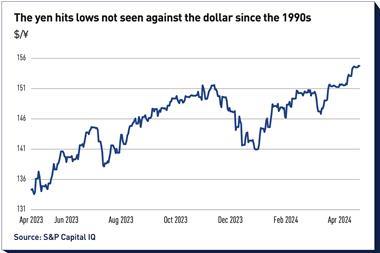After six months of consultation with actuaries, employers and employees, the UK government has finally put together a set of proposals to tackle the country’s pension fund crisis and ensure that employees are protected. But will the new proposals just end up costing companies whose plans are already underfunded more money?
Facing a gaping pensions hole to the tune of £65bn (E94bn) (as of August 2002: source, Watson Wyatt), UK companies are increasingly having to close their defined benefit schemes, or make additional contributions. Extensive media coverage of the situation has understandably made scheme members nervous, aggravated further by reports of employees losing all their pension savings in light of company insolvency in cases.
In June this year the UK Department of Work and Pensions announced a series of seemingly ‘bold’ amendments to company pension scheme regulations in attempt to protect members and make providing a pension easier for companies, but although the proposals may calm nervous members, some industry participants have voiced concerns that the costs are going to be too high for companies.
The first proposal is for a Pensions Protection Fund (PPF) inspired by the US Pension Benefit Guaranty Corp, with whom the government consulted, to which all private sector defined benefit schemes will contribute. The PPF will ensure that pensioners will be guaranteed 100% of their pension and non-pensioners will be guaranteed to receive 90% of the pension they have already built up in the event of the company going bust.
As with the US Pension Benefit Guaranty Corp, the PPF’s levy will comprise a flat-rate element and a risk-based element so that schemes which are most underfunded will have to pay more then their well-funded counterparts. The fear is, however, that although there are no exact details of the levy, the additional and potentially substantial premiums could further damage the financial situation of underfunded schemes. Schemes participating in the PBGC play a flat-rate premium of $19 (E16) per annum per individual covered, together with an additional variable rate of $9 per $1,000 unfunded vested benefits, and in order to avoid paying these additional premiums, there has been a strong incentive for some US companies to increase pension contributions. GM, for example, which has the US’s largest corporate pension scheme, had to contribute $4.8bn last year to avoid the PBGC premiums – the company’s pension liabilities exceeded the plan’s assets last year by $19.3bn, compared with a gap of $9.1bn the year before.
The idea of insurance for UK pension schemes has been discussed for some time, and generally welcomed as a way of ensuring that where company pensions have been promised, pensions will be delivered. But, points out the Confederation of British Industry (CBI): “Insurance is one solution, but the cost of providing occupational schemes has shot up hugely, and anything that adds to the cost could be extremely damaging”.
The Association of British Insurers (ABI) supports the proposed Pension Protection Fund but also remains cautious. Says Mary Francis, director general: “If set up properly, it could provide reassurance and boost confidence in pension saving. But a number of important practical questions remain. Will it really be viable without an ultimate guarantee from the government?” Indeed, the question of how much of a guarantee can it really provide, is being raised by many. The PBGC is itself in a predicament. Last year its losses amounted to $11.3bn, which naturally raises doubts about the extent to which it can provide for the 44m workers and retirees. The main problem, which will also have to be faced by the UK government over the PPF, is that essentially these insurance funds are investing in exactly the same assets as the pension funds which they are designed to support.
The ABI has highlighted three areas that need to be considered to ensure the “sustainable, long-term success” of the PPF. These are that the scheme will need to: be funded properly from the outset; set the levy at a rate that doesn’t drive more final salary schemes to close; and be clear about how and at what level compensation will be paid.
One of the main fears shared by the pensions industry is that increased costs will result in companies deciding to close their final salary schemes. Both the Association of Consulting
Actuaries and the Pensions Management Institute have expressed concerns. “Our concern is that employers’ reaction may be to discontinue their scheme for future benefits and run it on as a closed scheme. This is not in the interest of employees, when many well-intentioned employers have been making strenuous efforts to ensure that their pension schemes are properly funded on an ongoing basis. We doubt that this was what the government intended,” says Nigel Brodie, chairman of PMI’s external affairs committee.
Further cost to companies will also result from the government’s proposal to introduce a ‘full buy-out’ provision, which will ensure that solvent employers who want to wind up their defined benefit schemes will be made liable for the full costs of buying out members’ benefits. Currently if a solvent employer chooses to wind up their underfunded salary related scheme, non-pensioners can lose out significantly as they receive cash equivalent transfer value too low to provide them with the pension they were expecting in retirement. They are therefore faced with the choice of accepting a considerable cut to their pension or taking on the risk of re-investing the reduced cash transfer value. By ensuring that companies must have sufficient funds in the scheme to meet the full rights accrued by the employees if they wish to wind up, the new proposal reduces the flexibility of companies, says Dresdner Kleinwort Wasserstein. This could have a negative credit impact believes the bank.
Negative impact on company credit could also occur as a result of the proposal to abolish the minimum funding requirement and introduce scheme-specific funding requirements. The idea will be to allow scheme parties to be able to have greater control of the design of a fund and its financing, resulting in greater flexibility and freedom. Although greater flexibility in terms of the amount and timing of contributions would be credit positive, Dresdner believes that there could also be an increased risk that some companies might look to keep contribution levels at a lower level than necessary to maintain healthy funding levels. “This makes it even more important for the new PPF to set its premiums in such a way that there is a very strong incentive for employers to maintain healthy funding levels, since there is less certainty about the level of regulatory requirements,” says Dresdner.
The UK government vehemently denies, however, that there will be negative financial impact for companies, estimating, that its proposals will either be cost neutral or even cost beneficial for employers. Andrew Smith, pensions secretary claims that the proposals could save businesses up to £155m. The potential negative financial impact induced by the three proposals above, it believes, will be offset by a fourth proposal to reduce the cap on indexation of pension claims.
The 1995 Pensions Act introduced partial inflation cover by requiring schemes to index pensions in line with inflation up to a maximum of 5%. Says the Department of Work and Pensions: “Currently, 23% of contributions go on indexation yet long-term expectations of inflation match the government’s target of 2.5%. To reflect this we will reduce the LPI requirement to RPI capped at 2.5%. This eases the funding burden on schemes (which fund on the basis that over the very long term inflation will sometimes be higher than 2.5%), while ensuring that pension incomes are maintained. This will reduce costs and ease the burden, especially on less stable schemes.”
Alan Pickering, chairman of the European Federation of Retirement Provision and a partner at consultant Watson Wyatt, proposed the idea in a commissioned government report into pensions. One argument he put forward for the removal of inflation-proofing was that it drives employers to switch from defined benefit to defined contribution schemes. If this is the case, then perhaps the increase in costs and therefore the increase in closure of defined benefit schemes prompted by the government’s other proposals will be off-set. Andrew Smith maintains the proposals are “balanced”.
Whether the move to cut inflation protection will be easy to legislate is another story, and union opposition will be strong. Says Brendan Barber, general secretary of the Trades Union Congress: “Whilst we recognise the need for a balanced package in a voluntary environment we are disappointed that the government has chosen to allow employers to cut inflation proofing for scheme members. This could result in workers in retirement seeing the value of their pension reduce significantly if we return to a period of high inflation. The need for compulsory contributions to pensions be-comes more evident as we see the government trying to juggle with the voluntary approach. Long awaited pensions protections should not be paid for by reductions in benefits - we need more money in the pension pot.” Virgin Money director Gordon Maw agrees. “The move will help companies to balance the books today, but will leave pensioners looking anxiously at inflation figures in the future. The minute inflation goes above 2.5%, their income will be eroding in real terms.”
If a reduction in inflation protection does get past the unions, and more importantly does counter-balance the extra pay-outs facing schemes then employees may well end up with the pension protection they deserve at no expense to the employer. But the underlying problem for all schemes is out of government control - global economic recovery. Let us not forget that had the fall in financial markets not occurred, schemes would be merrily continuing to take contributions holidays and defined benefit schemes would not be in danger of closing. Government tweakings can protect employees and ease the burden for employers from now on, but the damage to company schemes has already been done, and taking more money out of schemes with shortfalls will only lengthen the road to recovery.












No comments yet